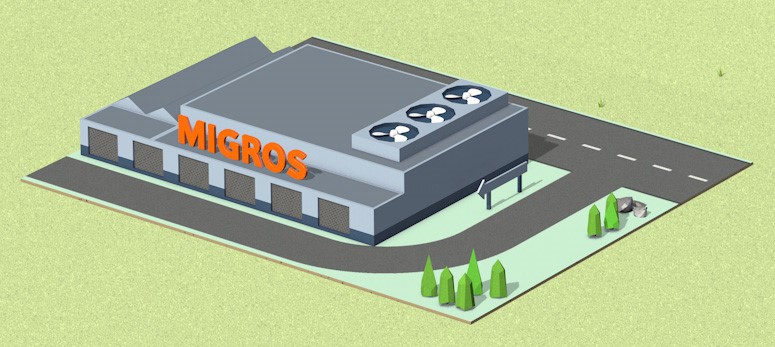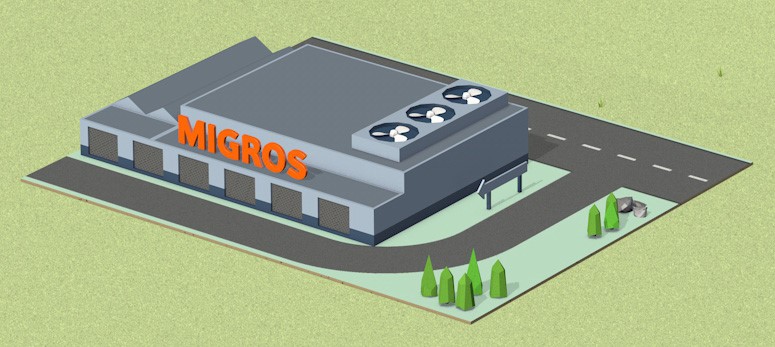



The FlexLast Project
Refrigerated warehouses store energy for smart
energy grid
energy grid
IBM, Migros, BKW and Swissgrid are collaborating in the smart grid pilot project FlexLast supported by the Swiss Federal Office of Energy. Based on two scenarios, this interactive diagram demonstrates how refrigerated warehouses at Migros, the largest Swiss retail company, act as a buffer to help balance fluctuations of the availability of sun and wind energy on the energy grid.
Click on ![]() to find out more.
to find out more.
To scenario 2
To scenario 1
Back to the overview
 OversupplyMany goods are delivered to the Migros refrigerated warehouses two days prior to a national holiday. With the sun shining and the wind blowing, an oversupply of renewable energy is available on the grid. Swissgrid and BKW inform the IBM system about the oversupply. All this information flows into the IBM analysis and forecasting models.
OversupplyMany goods are delivered to the Migros refrigerated warehouses two days prior to a national holiday. With the sun shining and the wind blowing, an oversupply of renewable energy is available on the grid. Swissgrid and BKW inform the IBM system about the oversupply. All this information flows into the IBM analysis and forecasting models. ControlIn response to the current oversupply, Swissgrid alerts BKW to use more power. BKW can select a higher consumption level for the refrigerated warehouses through the IBM system. Subsequently, the target temperature in the warehouses will be reduced and the cooling systems ramped up.
ControlIn response to the current oversupply, Swissgrid alerts BKW to use more power. BKW can select a higher consumption level for the refrigerated warehouses through the IBM system. Subsequently, the target temperature in the warehouses will be reduced and the cooling systems ramped up. Store energyThe refrigerated warehouses consume more power and thereby reduce the oversupply in the grid. The well-insulated refrigerated warehouses can now function without cooling for hours without damaging the goods. The excess energy is stored.
Store energyThe refrigerated warehouses consume more power and thereby reduce the oversupply in the grid. The well-insulated refrigerated warehouses can now function without cooling for hours without damaging the goods. The excess energy is stored.
 Insufficient supplyIt is a cold and rainy Saturday and only a few goods will be delivered to the refrigerated warehouses over the weekend. Wind power and photovoltaics supply only a small amount of energy to the grid. This leads to a shortfall in the supply of renewable energy to the grid. Swissgrid and BKW inform the IBM system of the insufficient supply. All this information flows into the IBM analysis and forecasting models.
Insufficient supplyIt is a cold and rainy Saturday and only a few goods will be delivered to the refrigerated warehouses over the weekend. Wind power and photovoltaics supply only a small amount of energy to the grid. This leads to a shortfall in the supply of renewable energy to the grid. Swissgrid and BKW inform the IBM system of the insufficient supply. All this information flows into the IBM analysis and forecasting models. ControlIn response to the current shortfall in supply, Swissgrid alerts BKW that regulation power is needed. BKW can select a lower consumption level for the refrigerated warehouses through the IBM system. Subsequently, the target temperature is increased and the cooling systems are ramped down.
ControlIn response to the current shortfall in supply, Swissgrid alerts BKW that regulation power is needed. BKW can select a lower consumption level for the refrigerated warehouses through the IBM system. Subsequently, the target temperature is increased and the cooling systems are ramped down. Save energyLess energy is being consumed due to the higher target temperature. The BKW can therefore provide the regulation power required by Swissgrid. Moreover, the Migros refrigerated warehouses can maintain the temperature without additional cooling over the weekend due to the low turnover of goods.
Save energyLess energy is being consumed due to the higher target temperature. The BKW can therefore provide the regulation power required by Swissgrid. Moreover, the Migros refrigerated warehouses can maintain the temperature without additional cooling over the weekend due to the low turnover of goods.


Power line
Data line



High power production from renewable energy

Oversupply of power

Internal temperature of the refrigerated warehouses
Heat wave forecast
High turnover of goods
Two days before a public holiday
External temperature 36°C






Regulation power requested

Target temperature

Current temperature

Oversupply of power will be compensated
Internal temperature will be reduced to
−29°C
−29°C
Increased power consumption



Low power supply from renewable energy

Insufficient power supply

Internal temperature of the refrigerated warehouses
Low temperature forecast
Low turnover of goods
Weekend
External temperature 10°C






Regulation power requested

Internal temperature of the refrigerated warehouses

Target temperature

Insufficient power supply will be compensated
Internal temperature increases to −26°C
Reduced power consumption
Cooling systems are
ramped down
ramped down
Refrigerated warehouses as “flexible loads”
The Migros refrigerated warehouses are so well insulated that the internal temperature can be maintained for several hours even when the cooling is off. The target temperature range is between −24 and −29°C. Based on this range, IBM analytics technology determines the minimum and maximum energy requirement for the following week. Within this permitted range, the energy supplier BKW can adapt the energy consumption level dynamically to help balance the energy grid. The refrigerated warehouse becomes an energy storage and a source of so-called regulation power. This “flexible load control” (Last is German for load) gave the project its name.Grid stability and power transmission
The Swiss national grid operator Swissgrid is responsible for network stability. The power grid is stable when supply and demand are in balance. With the increasing proportion of renewable energy sources, this will become a significant challenge for the future energy grid because wind and solar energy are not always available when needed. Swissgrid is therefore interested in finding additional sources of regulation power.Energy production and supply
The power generation company BKW distributes electricity throughout the Canton of Bern. To balance fluctuations in the power supply, it delivers and obtains regulation power to or from Swissgrid, respectively. Now within the FlexLast project, BKW can also rely on the refrigerated warehouses.Analytics for FlexLast
Using analytics, forecasting and optimization software developed by IBM Research – Zurich, the minimum and maximum energy consumption for the refrigerated warehouses is calculated for the pending week. The system allows a precise forecast of the energy requirement and of the flexibility for providing regulation power. The IBM software uses a range of information such as measured data (internal and external temperatures, power consumption of the cooling systems etc.), weather forecasts, power grid data from BKW and Swissgrid, expected changes to the inventory (e.g. before public holidays) as well as parameters that ensure the quality of the stored goods.

